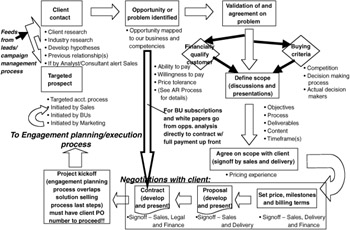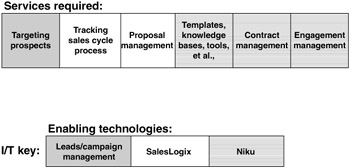Process Decomposition
|
| < Day Day Up > |
|
As the first set of mapping activities, process decomposition reveals the rationale behind each key business process and its underlying assumptions and operating principles. It requires a clear and complete high-level map or workflow of how the enterprise executes that process, citing all its essential business rules, process components, and deliverables. As a complement to this map, a business analyst prepares a table that defines the inputs, outputs, and deliverables for each process step. This element documents the value chain of the process under analysis. Lastly, as part of process decomposition, the team maps major process components to their associated enabling technologies. In our example, solution selling within the HG & Co. consulting firm, the business process may be defined as follows:
-
Team-based, problem-focused selling process that proactively identifies business opportunities and presents the value proposition for addressing those opportunities to targeted, qualified clients
-
Holistic process that encompasses diagnosing, proposing, and closing a business proposition that solves a client business problem
-
Selling solutions that are tailored and customized to the particular needs of a given client, even though the actual deliverables may be cast from standardized components
-
Intense collaboration to derive the right result (often a cross-organization, team-sell approach is required)
-
Not a product sheet and a price but a process that draws on unique competencies and knowledge bases to create a complete solution for the client
Note that this definition is concise and explicit, providing all interested parties with a clear sense of what the firm means by solution selling. Note also the references to knowledge bases, implying an underlying set of IT-enabled components to the process. The solution selling's assumptions and operating principles further clarify the working definition of the process:
-
Solution selling is an iterative process
-
Negotiating and communicating with the client throughout the process is key; antennas up for client pain, restraints, preferences, etc.
-
Price should not be discussed for the first time with client in the proposal; it should be addressed as early as possible and certainly during scoping and scope agreement
-
Consultants must involve sales as they contact clients or prospective clients, and they must record these efforts in the appropriate relationship log in either the salesforce automation system or the professional services administration system
-
Whoever initiates a solution selling instance must get others involved as early as appropriate to ensure the process's success
-
Process must scale with the business
-
Where possible and appropriate (e.g., for off-the-shelf products and services), payment in full should be required up front
-
No new work will take place without a credit check and the clearing of past-due balances (accounts)
Here, the firm's process owners have clearly articulated norms of behavior and performance standards, if not desired process outcomes. From the IT project team's perspective, this information begs the question, "How can IT enable and empower this process?" To answer this question, the IT team must identify and map the entire process in some detail, then examine each process activity for investment opportunities. As a start to formal mapping, simply make a list of all key process steps in sequential order. Do not worry about the rigor of your sequencing or leaving out details. Your list is merely an aid in drawing the process map, which will accommodate concurrent activities. Its execution will also solicit from your working client(s) and the project team process steps that you may have neglected. The list for solution selling process steps runs as follows:
-
Target prospect
-
Contact/interact with the client
-
Identify/define opportunity
-
Validate and agree on problem/opportunity (the firm and the client)
-
Qualify client
-
Identify buying criteria
-
Scope potential assignment
-
Agree on scope with client
-
Set price (start negotiating with client)
-
Approve/sign off proposal to client by senior management
-
Prepare and present proposal (continue negotiating with client)
-
Prepare and present contract (finalize negotiations with client)
-
Obtain purchase order/PO number from client before the start of the assignment
-
Kick off project
-
Track interim process results
-
Track process outcomes
-
Report on process results to appropriate project stakeholders
With this checklist in hand, the time has come to develop a business process map. See Exhibit 1 (where BU equals business unit).
Exhibit 1: A Business Process Map for the HG & Co. Selling Solution

This example of a process workflow is not particularly detailed, nor does it need to be. Other process mapping elements complement the actual flow diagram and fill in the particulars. Nevertheless, the diagram does capture primary process steps, decision trees, concise roles and responsibilities, summary business rules, and desired process outcomes. With this blueprint in hand, the project team and its working client partners will next create a simple matrix that lists the following:
-
Each process step
-
Inputs and outputs of that step
-
Party or parties responsible for that step's execution and deliverables
-
Customer/process deliverables emerging from that step
This exercise makes explicit what is perhaps implied in the workflow. Furthermore, it formally sets down the more incremental elements of the process, as well as the desired outcomes and the responsible parties. In the case of our solution selling example, the matrix appears as in Exhibit 2.
Exhibit 2: The Components of Process Decomposition
| Process Step | Inputs/Outputs Described | Role Owners | Customer/Process Deliverables |
|---|---|---|---|
| Target Prospect | Inputs: market/prospect research and analysis Outputs: targets agreed to | Analysts, Sales, BUs | List of qualified targets |
| Contact/interact with the client | Inputs: qualified targets Outputs: prospects approached | Consultants, account managers | Approach to specific target |
| Identify/define opportunity | Inputs: industry, market, prospect information Outputs: specific opportunities defined; if an off-the-shelf product, go directly to contract | Sales, consultants | Sufficient information to craft an approach for prospect; contract |
| Validate/agree on problem/opportunity | Inputs: opportunities; ideas presented Outputs: consensus on focus for sales and delivery teams | Sales, delivery, client | Consensus with client on opportunity under consideration |
| Qualify client | Inputs: credit checks; client financials and information Outputs: green light on client's ability and willingness to pay; determination of client's price tolerance | Sales, finance | Determine client's ability and willingness to pay; price tolerance |
| Identify buying criteria | Inputs: client information; competitive intelligence Outputs: alignment of the firm's selling process with prospect's buying process | Sales | Determine how decision is to be made and by whom; competition |
| Scope potential assignment | Inputs: client information; process intelligence Outputs: scope document | Sales, delivery | Scope document |
| Agree on scope | Inputs: scope document Outputs: consensus on scope | Sales, delivery, client | Consensus with client on scope |
| Set price | Inputs: scope document; pricing experience Outputs: pricing for proposal | Sales, delivery | Based on scope, price determined |
| Prepare and present proposal | Inputs: scope document and pricing decision; resources availability Outputs: proposal | Sales, delivery | Proposal delivered |
| Prepare and present contract | Inputs: proposal and negotiations Outputs: contract | Sales, delivery | Contract delivered |
| Kick off project | Inputs: contract Outputs: engagement and delivery plans | Engagement management team | Project initiated |
To conclude mapping process decomposition activities, capture the current state of those IT systems that enable the business process being mapped. For example, in the case of solution selling, the HG & Co. consulting firm employs a lead/sales campaign management system, a customer relationship management (CRM) system, and a professional services administration system (for engagement management and delivery, and for project cost accounting). See Exhibit 3.
Exhibit 3: A Map of Business Process IT Enablement

The importance of this modest step may not be apparent but in acknowledging the information systems that currently support the business process, the IT team identifies both potential sources of knowledge content and potential technology platforms for constructing an enhanced or replacement IT solution. For example, HG & Co. Consulting's CRM system tracks sales cycle data. With this information, the IT team can enable an information service that links new sales personnel with sales veterans who possess the requisite expertise. Similarly, the professional services system already houses project engagement knowledge that could be shared with new service teams faced with similar assignments. In total, the elements of process decomposition provide the IT project team with a rich understanding of the business process, its information management requirements, and the knowledge artifacts that it generates for sharing and reuse.
|
| < Day Day Up > |
|
EAN: 2147483647
Pages: 132